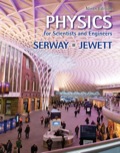
(a)
The electron would be in equilibrium at centre and if displaced would experience a restoring force.
(a)
Answer to Problem 24.62CP
The electron would be in equilibrium at centre and if displaced would experience a restoring force of magnitude
Explanation of Solution
Given info:
Consider the field distance
Write the expression of Guass’s law.
Here,
Write the expression for area of sphere.
Here,
Substitute
Write the expression for electric charge.
Here,
Substitute
Write the expression for volume of sphere.
Write the expression for density of sphere.
Here,
Substitute
Substitute
So,
The above electric field is directed outward.
The expression for the force is,
Substitute
Conclusion:
Therefore, the electron would be in equilibrium at centre and if displaced would experience a restoring force of magnitude
(b)
To show: The constant
(b)
Answer to Problem 24.62CP
The constant
Explanation of Solution
Given info:
Write the expression for spring force.
Here,
Also, the field force is,
Equate the above two force equations.
Substitute
Conclusion:
Therefore, the constant
(c)
The expression for the frequency
(c)
Answer to Problem 24.62CP
The expression for the frequency
Explanation of Solution
Given info:
According to Newton’s second law of motion,
Here,
Also, the field force is,
Equate the above two force equations.
Rearrange the above equation to get
Compare the above equation with the simple harmonic wave equation which is,
Equate the above two acceleration equations.
From the above equation
Write the general expression for frequency of
Substitute
Substitute
Conclusion:
Therefore, the expression for the frequency
(d)
The value of radius of orbit.
(d)
Answer to Problem 24.62CP
The value for
Explanation of Solution
Given info:
Write the expression for frequency
Rearrange the above equation to get
Substitute
Conclusion:
Therefore, the value for
Want to see more full solutions like this?
Chapter 24 Solutions
EBK PHYSICS FOR SCIENTISTS AND ENGINEER
- Min Min is hanging from her spring-arms off the edge of the level. Due to the spring like nature of her arms she is bouncing up and down in simple harmonic motion with a maximum displacement from equilibrium of 0.118 m. The spring constant of Min-Min’s arms is 9560. N/m and she has a mass of 87.5 kg. What is the period at which she oscillates? Find her maximum speed. Find her speed when she is located 5.00 cm from her equilibrium position.arrow_forward(a) What magnification in multiples is produced by a 0.150 cm focal length microscope objective that is 0.160 cm from the object being viewed? 15.9 (b) What is the overall magnification in multiples if an eyepiece that produces a magnification of 7.90x is used? 126 × ×arrow_forwardGravitational Potential Energyarrow_forward
- E = кедо Xo A continuous line of charge lies along the x axis, extending from x = +x to positive infinity. The line carries positive charge with a uniform linear charge density 10. (a) What is the magnitude of the electric field at the origin? (Use the following as necessary: 10, Xo, and ke.) (b) What is the direction of the electric field at the origin? O O O O O O G -y +z ○ -z +x -x +yarrow_forwardInclude free body diagramarrow_forward2 Spring 2025 -03 PITT Calculate the acceleration of a skier heading down a 10.0° slope, assuming the coefficient of cold coast at a constant velocity. You can neglect air resistance in both parts. friction for waxed wood on wet snow fly 0.1 (b) Find the angle of the slope down which this skier Given: 9 = ? 8=10° 4=0.1arrow_forward
- dry 5. (a) When rebuilding her car's engine, a physics major must exert 300 N of force to insert a c piston into a steel cylinder. What is the normal force between the piston and cyli=030 What force would she have to exert if the steel parts were oiled? k F = 306N 2 =0.03 (arrow_forwardInclude free body diagramarrow_forwardInclude free body diagramarrow_forward
- Test 2 МК 02 5. (a) When rebuilding her car's engine, a physics major must exert 300 N of force to insert a dry = 0.03 (15 pts) piston into a steel cylinder. What is the normal force between the piston and cylinder? What force would she have to exert if the steel parts were oiled? Mk Giren F = 306N MK-0.3 UK = 0.03 NF = ?arrow_forward2. A powerful motorcycle can produce an acceleration of 3.50 m/s² while traveling at 90.0 km/h. At that speed the forces resisting motion, including friction and air resistance, total 400 N. (Air resistance is analogous to air friction. It always opposes the motion of an object.) What force does the motorcycle exert backward on the ground to produce its acceleration if the mass of the motorcycle with rider is 245 ke? a = 350 m/s 2arrow_forward2. A powerful motorcycle can produce an acceleration of 3.50 m/s² while traveling at 90.0 km/h. At that speed the forces resisting motion, including friction and air resistance, total 400 N. (Air resistance is analogous to air friction. It always opposes the motion of an object.) What force does the motorcycle exert backward on the ground to produce its acceleration if the mass of the motorcycle with rider is 245 kg? (10 pts) a = 3.50 m/s 2 distance 90 km/h = 3.50m/62 M = 245garrow_forward
 University Physics Volume 1PhysicsISBN:9781938168277Author:William Moebs, Samuel J. Ling, Jeff SannyPublisher:OpenStax - Rice University
University Physics Volume 1PhysicsISBN:9781938168277Author:William Moebs, Samuel J. Ling, Jeff SannyPublisher:OpenStax - Rice University Modern PhysicsPhysicsISBN:9781111794378Author:Raymond A. Serway, Clement J. Moses, Curt A. MoyerPublisher:Cengage Learning
Modern PhysicsPhysicsISBN:9781111794378Author:Raymond A. Serway, Clement J. Moses, Curt A. MoyerPublisher:Cengage Learning University Physics Volume 3PhysicsISBN:9781938168185Author:William Moebs, Jeff SannyPublisher:OpenStax
University Physics Volume 3PhysicsISBN:9781938168185Author:William Moebs, Jeff SannyPublisher:OpenStax College PhysicsPhysicsISBN:9781285737027Author:Raymond A. Serway, Chris VuillePublisher:Cengage Learning
College PhysicsPhysicsISBN:9781285737027Author:Raymond A. Serway, Chris VuillePublisher:Cengage Learning College PhysicsPhysicsISBN:9781938168000Author:Paul Peter Urone, Roger HinrichsPublisher:OpenStax College
College PhysicsPhysicsISBN:9781938168000Author:Paul Peter Urone, Roger HinrichsPublisher:OpenStax College Principles of Physics: A Calculus-Based TextPhysicsISBN:9781133104261Author:Raymond A. Serway, John W. JewettPublisher:Cengage Learning
Principles of Physics: A Calculus-Based TextPhysicsISBN:9781133104261Author:Raymond A. Serway, John W. JewettPublisher:Cengage Learning





